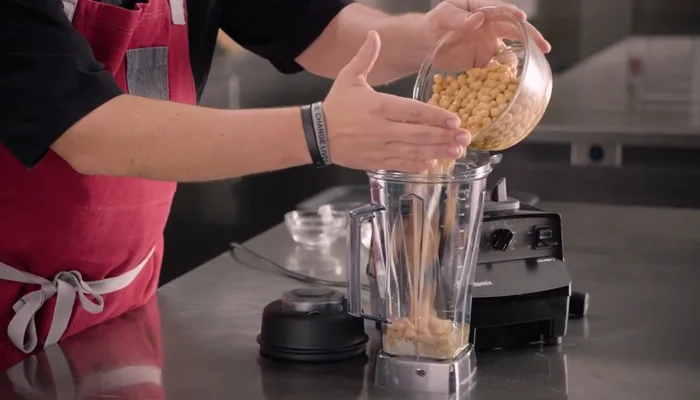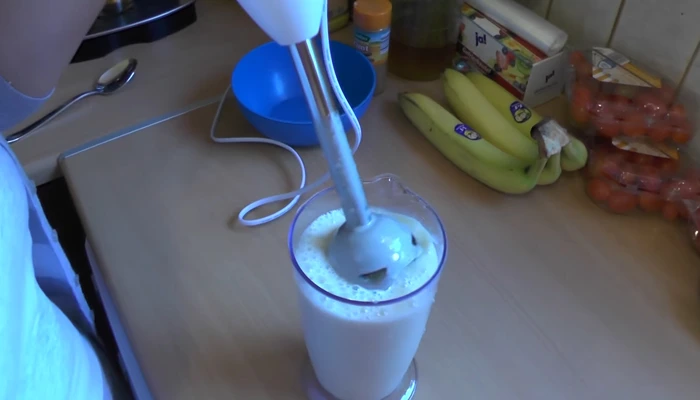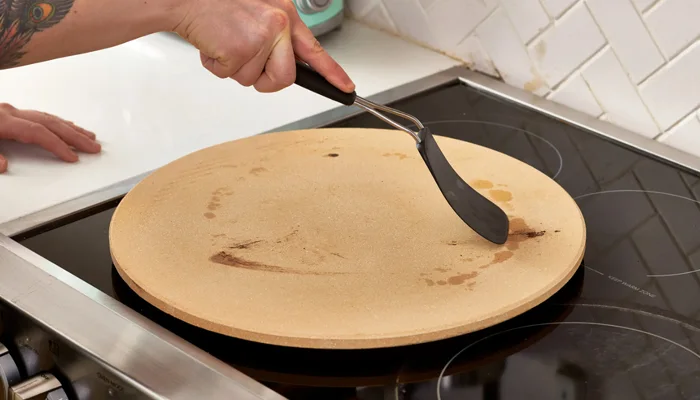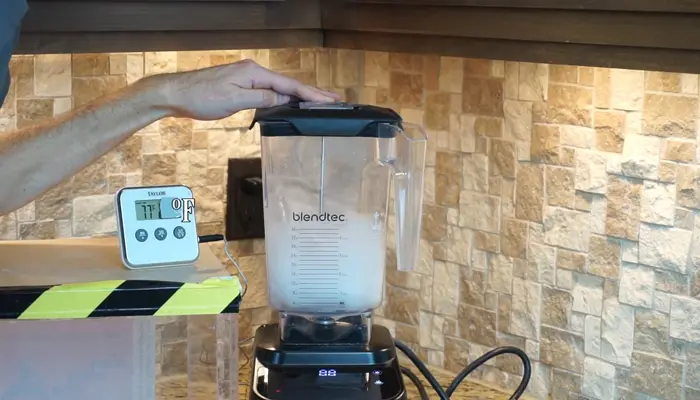Can I Use a Blender Instead of a Food Processor for Hummus?
If you’re looking to make a delicious and healthy snack, you should try hummus. It is a great source of protein and fiber, and it’s really easy to make.
When making hummus, a food processor is a standard kitchen tool. What happens if you don’t have a food processor, though? You have a blender but don’t want to go out and buy a food processor just for one dish.
A common question comes to your mind, “Can I use a blender instead of a food processor for hummus?” The answer is yes. You can make delicious hummus in a blender.
Here we will discuss the pros & cons of using a blender instead of a food processor for hummus and the process of making hummus in a blender.
Can I Use a Blender Instead of a Food Processor for Hummus: The Pros and Cons

Making hummus at home is a delicious and healthy way to enjoy this classic Middle Eastern dish. If you don’t have the best food processor such as a Cuisinart food processor, can you use a blender such as an immersion blender instead? Let’s explore the pros and cons of using a blender to make hummus.
Benefits of Using a blender for Hummus:
Blenders are most commonly used for making smoothies or juices, but they can also be used to make hummus. Here are a few benefits of using a blender:
Easier to Maintain:
One of the main benefits of using a blender is that it requires much less maintenance than a food processor. Blenders have fewer parts and are much simpler to disassemble and reassemble. This means that you won’t have to spend as much time maintaining your blender, which is a huge plus.
Faster:
Another benefit of using a blender is faster than a food processor. Blenders can pulverize ingredients in seconds, whereas food processors can take minutes. This is especially helpful if you are short on time or want to make a large batch of hummus.
Larger Capacity:
Blenders also typically have larger capacities than food processors. Because you can take use of large pitchers or bowls with blenders, you can make a larger batch of hummus at once.
It is ideal if you are entertaining guests or want to have leftovers. This is helpful if you want to make a large batch of hummus or have a large family.
More Affordable:
Blenders such as Vitamix are generally more affordable than food processors. If you’re on a budget or don’t want to spend a lot of money on kitchen appliances, a blender is a great option.
Easier to Store:
Blenders are also easier to store than food processors. Blenders can be stored on the countertop or in a cabinet, whereas food processors require more space because of their larger size.
Can Make Hot and Cold Liquid:
Blenders can be used to make both hot and cold liquids, whereas food processors can only make cold liquids. This means that you can use your blender to make soups, sauces, and dips in addition to hummus.
Drawbacks of Using a Blender for Hummus:
Not everyone has had success making hummus in a blender. If you’re not careful, you may end up with a runny or watery consistency.
Not as Smooth:
One downside of using a blender is that your hummus will not be as smooth as if you used a food processor. A food processor can create smooth hummus, whereas a blender will leave your hummus with a slightly grainy texture.
Less Control:
Another drawback of using a blender is that you will have less control over the consistency of your hummus. You can pulse the ingredients until they reach your desired consistency with a food processor. It can be difficult to achieve the same level of control with a blender.
The Health Benefits OF Hummus:
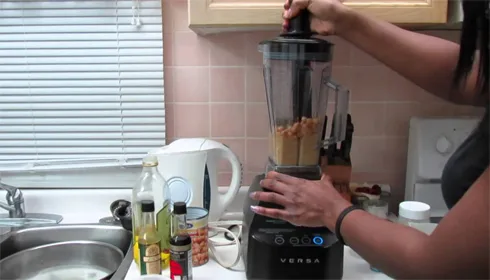
Hummus is a delicious and healthy dip that originated in the Middle East. It is made from chickpeas, tahini, olive oil, garlic, and fresh lemon juice.
It is a great source of protein and fiber and can be used as a dip or spread on sandwiches or wraps. Hummus has many health benefits, including:
Helping to Regulate Blood Sugar Levels:
Hummus is a low-glycemic food, which means it does not cause spikes in blood sugar levels. This is due to the slow release of carbohydrates from chickpeas and the high fiber content.
Numerous studies have shown that eating high-fiber, high-protein foods can help to control diabetes. In addition, the healthy fats in classic hummus can help to lower cholesterol levels and improve heart health. To improve your health, consider adding some hummus to your next meal!
Reducing Inflammation:
Hummus is also a good source of antioxidants, which can help to reduce inflammation in the body. Antioxidants are substances that protect cells from damage.
Some of the antioxidants found in hummus include vitamins C and E, carotenoids, and flavonoids. These nutrients can help to reduce inflammation throughout the body and reduce the risk of chronic diseases such as heart disease, cancer, and arthritis.
Overall, when eaten regularly as part of a balanced diet, hummus can effectively promote long-term health and reduce the risk of chronic illness. So go ahead and treat yourself to a few spoonfuls of this tasty Mediterranean treat!
Supporting Gut Health:
Hummus is also a good source of prebiotics. Prebiotics are a type of dietary fiber that helps to promote the growth of healthy bacteria in the gut.
A healthy gut microbiome is important for health, including immunity, digestion, and mental health. Numerous studies have shown that consuming prebiotic-rich foods can help to improve gut health.
Preventing Gastrointestinal Disorder:
Furthermore, studies have indicated that hummus may be useful in preventing gastrointestinal disorders like irritable bowel syndrome, ulcerative colitis, and other conditions. Therefore, hummus can be a great addition to your diet if you’re looking to improve your gut health.
Improving Heart Health:
The healthy fats in hummus can also help to improve heart health. Hummus is also a good source of healthy fats, including omega-three fatty acids. These nutrients are important for heart health and have been linked with a reduced risk of heart disease.
In addition, the antioxidants in hummus can help to protect the heart from damage and reduce inflammation. Therefore, including hummus in your diet can be a great way to improve your overall heart health.
Protecting Against Osteoporosis:
Another health benefit of hummus is that it can help to protect against osteoporosis. Osteoporosis is a condition that causes bones to become weak and break easily.
Studies have shown that the magnesium in hummus can help to improve bone health and reduce the risk of osteoporosis. In addition, the antioxidants in hummus can help to protect bones from damage.
Helping with Weight Loss:
Hummus can also be helpful for those looking to lose weight. The combination of protein, fiber, and healthy fats makes it a great food for weight loss.
In addition, the antioxidants and anti-inflammatory nutrients in hummus can help to promote a healthy weight. Therefore, including hummus in your diet can be a great way to reach your weight loss goals.
How To Make The Smoothest Hummus Recipe in a Blender?
Making the smoothest hummus in a blender is very simple. If you want to try making hummus in a blender, here is a simple recipe.
Ingredients:
- ½ cup cooked chickpeas or garbanzo beans
- ¼ cup tahini
- ¼ cup olive oil
- -½ cup fresh lemon juice
- ½ teaspoon ground cumin
- ½ teaspoon garlic powder
- Salt and pepper to taste
Instructions:
Step 01. Add the Chickpeas:
Start by adding the fresh chickpeas to the blender. Drain the cooked chickpeas completely with a colander, removing all the cooking liquid. If you’re using canned chickpeas, drain and rinse them first.
Step 02. Add Other Ingredients:
Next, add the tahini, olive oil, lemon juice, cumin, garlic powder, salt, and pepper to the blender.
Step 03. Blend the Hummus:
Now, blend the ingredients until the hummus is smooth. Add more olive oil or lemon juice if you want a thinner consistency.
Step 04. Serve and Enjoy:
Finally, transfer the hummus to a serving dish and enjoy! Serve with pita bread, vegetables, or crackers. You can store any leftover hummus in an airtight container in the fridge for up to a week.
Fresh Chickpeas VS Canned Chickpeas: Which is Better for Hummus?
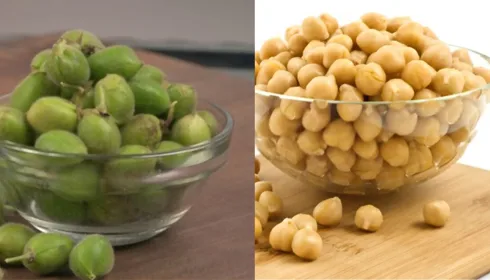
The debate over fresh versus canned chickpeas is a long and heated one. There are pros and cons to both types of chickpeas, but ultimately it comes down to personal preference.
Smoothest Possible Hummus:
If you’re looking for the smoothest possible hummus, then canned chickpeas are going to be your best bet. Canned chickpeas are already cooked, so they’ll blend up more easily.
Faster Making Hummus:
Fresh chickpeas will also work, but you may need to cook them first. This can make the process of making hummus a bit more time-consuming.
Most Nutritious Option:
If you’re looking for the most nutritious option, then fresh chickpeas are the way to go. Fresh chickpeas are a good source of fiber, vitamins, and minerals.
Canned chickpeas are also nutritious, but they can be high in sodium. If you’re watching your salt intake, you may want to opt for fresh chickpeas instead.
The bottom line is that both fresh and canned chickpeas will work for making hummus. It’s up to you to decide which type of chickpea you prefer.
Hummus in Different Flavors:
If you want to change up the flavor of your hummus, there are many different ways to do so. Here are some ideas.
- Roasted Red Pepper Hummus
- Sun-dried Tomato
- Chocolate Hummus
- Basil Pesto
- Roasted Cauliflower
- Roasted Beet
- Green Hummus
- Artichoke
- Roasted Garlic
- Add roasted red peppers, sun-dried tomatoes, or olives for a flavorful twist.
- For a sweeter version such as chocolate hummus, add honey, dates, or figs.
- You can also add fresh herbs like basil pesto, mint, or cilantro for a flavorful boost.
- Add roasted cauliflower, beets, or sweet potatoes for a fun and colorful twist.
- You can use roasted beet greens, garlic, or onion for a more savory flavor.
- Artichoke hearts, spinach, or kale can also be added for a nutrient-rich boost.
- If you love the flavor of garlic, you’ll love this roasted garlic hummus recipe.
Try one of these variations or come up with your own! The possibilities are endless. As you can see, there are many benefits to including hummus in your diet.
Types of Blenders to Make Hummus:
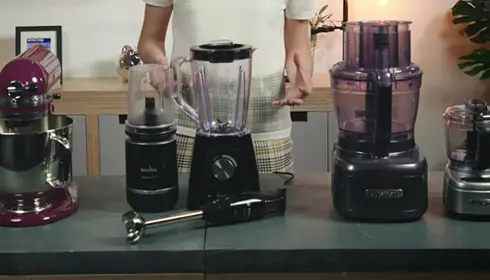
Now that you know how to make hummus, let’s talk about the different types of blenders you can use.
Immersion Blender:
An immersion blender is a handheld blender that can be used to blend food directly into a container. It is also known as a stick blender. This type of blender is ideal for making small batches of hummus.
Immersion blenders are very convenient and easy to use. They are also relatively inexpensive, so they’re a great option for budget-minded shoppers.
Hand Blender:
A hand blender is a perfect tool for making hummus at home. Unlike a traditional food processor or Cuisinart food processor, a hand blender uses blades attached to an ergonomic handle, making it easy to maneuver and control.
In addition, because of its small size and compact design, it can be easily stored in a kitchen cupboard when not in use. Furthermore, this type of blender is specifically designed for blending dense, thick solid food items such as chickpeas, making it the ideal tool for making hummus.
Countertop Blender:
A countertop blender can be a useful tool for making hummus. The blades of the blender can quickly and easily chop up the ingredients, and the blender’s motor can provide the power needed to create a smooth and creamy texture.
You can also add additional flavors to your hummus, such as cumin or red pepper flakes. If you find that your hummus is too thick, you can add more liquid until it reaches the desired consistency.
Whether you’re a seasoned chef or a beginner cook, a countertop blender can be a helpful tool for making delicious and healthy dishes like hummus.
If you are looking for the best blender for hummus, here is the list of three top-rated blenders that will make your hummus making process easier.
Vitamix Blender:
Vitamix is one of the most popular brands of high-powered blenders. The Vitamix Blender is a versatile tool that can be used to make soups, sauces, smoothies, and of course, hummus.
This blender features a powerful motor that can easily chop and blend ingredients. In addition, the Vitamix Blender comes with a tamper tool that can be used to push ingredients down into the blades, making it easier to blend them.
The Vitamix Blender is a great option for people who want a high-quality and powerful blender. However, it is important to note that this blender is one of the more expensive options on the market.
Cuisinart Blender:
The Cuisinart blender is the perfect appliance for making hummus. Its sharp blades and high power motor make short work of chickpeas, garlic, and tahini, yielding a smooth and creamy dip in just seconds.
And cleanup is a breeze; simply pop the blending jar in the dishwasher and you’re done. If you’re looking for an easy and delicious way to liven up your next party or potluck, consider making a batch of hummus with the Cuisinart blender.
Your guests will be impressed by your culinary skills, and you’ll be able to enjoy the party without spending hours in the kitchen.
Ninja Blender:
When it comes to creating delicious homemade hummus, there’s no better tool than the Ninja blender. Whether you’re looking for a smooth, creamy consistency or a thick and hearty blend, this powerful machine can deliver you exactly.
Additionally, the Ninja blender is an incredibly versatile kitchen appliance that can be used to create everything from frozen desserts to baby food. So if you find yourself craving some fresh and flavorful homemade creamy hummus, look no further than the trusty Ninja blender.
With its high-powered blades and powerful motor, this indispensable appliance will have your hummus ready in no time! And with hundreds of different flavor combinations to choose from, you’ll never run out of inspiration when it comes to whipping up this tasty treat.
FAQs:
Q: Can I use a Hand Blender to Make Hummus?

A hand blender can easily be used to puree dried chickpeas, garlic, and other ingredients into a smooth dip. Plus, it’s easy to clean – simply rinse the blades under running water after use. A hand blender is the best way to make perfect hummus quickly and easily.
Q: How do You Grind Chickpeas without a Food Processor?
Chickpeas, also known as garbanzo beans, are a nutty and versatile legume that can be used in a variety of dishes. If you don’t have a food processor, you can use a potato masher. Another option is to use a food chopper.
Q: Is a Blender and Food Processor the Same?
A food processor is a kitchen appliance that can be used to chop, slice, and shred food. A blender is a kitchen appliance that is used to purée or blend food.
Q: What can you Replace Tahini with in Hummus?
If you need to replace tahini in your hummus recipe, there are several great options. Nut butter, such as cashew, almond, and peanut butter, are all great alternatives to this popular hummus dip. Additionally, avocados can be used in place of tahini if you prefer a more tangy option.
Conclusion:
Hummus is a delicious and healthy dip that has many benefits. It can be made in a blender or food processor, but the consistency and level of control may be different. Be sure to experiment with different methods and find the one that works best for you.
If you are short on time or want an easy way to make large batches of basic hummus, then a blender is the way to go. However, if you are looking for a smooth and silky consistency, a food processor is better.
We hope this article solved your question, “Can I use a blender instead of a food processor for hummus?” and gives you the information you need to make the best decision for your next batch of this delicious dip.
